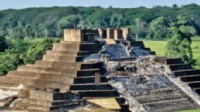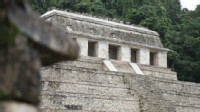ABC NEWS
The textbooks will tell you that the Mayan people thrived in Central America from about 250 to 900 A.D., building magnificent temples in Guatemala, Honduras, Belize and southern Mexico.
But could they possibly have left stone ruins in the mountains of North Georgia? Richard Thornton thinks so. He says he's an architect by training, but has been researching the history of native people in and around Georgia for years. On Examiner.com, he wrote about an 1,100-year-old archeological site near Georgia's highest mountain, Brasstown Bald, that he said "is possibly the site of the fabled city of Yupaha, which Spanish explorer Hernando de Soto failed to find in 1540."
This might all be fairly arcane stuff, except that an archeologist he cited, Mark Williams of the University of Georgia, took exception. In the comments section after Thornton's piece, he wrote, "I am the archaeologist Mark Williams mentioned in this article. This is total and complete bunk. There is no evidence of Maya in Georgia. Move along now."
Mayans Ahead of Their Time Watch Video
Will the World End in 2012? Watch Video
Countdown to 2012: Apocalypse Soon? Watch Video
Immediately the story exploded. In comments on Examiner, as well as on Facebook and in emails, users piled on. One woman called Williams "completely pompous and arrogant." A man wrote he was "completely disrespectful to the Public at large." Another said he would urge the state of Georgia to cut off funding for Williams' academic department at the university.
All of this left Thornton, who writes often about the Maya for Examiner.com, "dumfounded."
"I actually was giving Williams a plug," he said in an interview with ABC News. "I've got a regular readership, but this thing just went viral."
Thornton, who said he is Georgia Creek Indian by birth, volunteered that doing research about Mesoamerican culture in the U.S. has been a difficult way to make a living. For nine months before the Examiner hired him, he said he was so poor he had to live out of a tent. He said he now makes money by writing online and lecturing.
Some of his conclusions about the Mayan connection to the southern U.S., he said, are based on oral history. There are place names in Georgia and North Carolina, he said, that are very similar to Mayan words. And the ruins near Brasstown Bald, he said, include mounds and irrigation terraces similar to those found at Mayan settlements in Central America.
Williams, the doubting archeologist, had many online defenders. "While there are many, many compelling parallels between Central American and North American indigenous mythologies," wrote one, "that does not mean there was direct evidence that the post-Classic Period Collapse Maya emigrated all the way to Georgia."
Williams stood his ground against Thornton's suggestion that Brasstown Bald has any Mayan roots. "The sites are certainly those of Native Americans of prehistoric Georgia," he wrote in an email. "Wild theories are not new, but the web simply spreads them faster than ever."





No comments:
Post a Comment